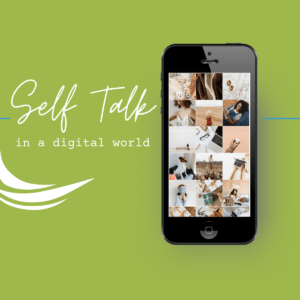
For the past few decades we have become increasingly connected thanks to technology. Now, thanks to the global pandemic that began in 2020, we are closer than ever before. From Zoom to text, the speed and intimacy with which we can access one another has given us many wonderful things. We need to remember that with those advancements it is important that we pay attention to our mental health. One of the ways to protect and care for our mental health is through self-talk, and through our inner dialogues, we can work toward self-acceptance.
When we hear “self-acceptance,” many of us think immediately of self-esteem but the two concepts are different enough that they are worth covering here. Self-esteem centers mostly on the positive, aspects of our personalities that make us feel good. While self-acceptance, on the other hand, is a global, all-encompassing inventory and appreciation for all parts of our personalities; even the parts that are less than favored. Self-acceptance is important because, as we grow from childhood to adulthood, carving out a sense of identity helps shape how we view the world and others alongside ourselves. If you have ever gone to the gym and been convinced that everyone was focused on you and your flaws, you see what I mean.
In a technologically connected world, we encounter hundreds of those internal judgments every day due to the information we take in from the world around us. But what can we do about it? How do we not internalize any potentially negative messages about ourselves? The answers are a lot closer than we realize.
Self-Talk Impacts Self-Acceptance
You may be thinking, perhaps not incorrectly, that self-acceptance means self-improvement. Because surely, there is something there that we need to fix or repair to be better than we currently are, right? But no! There is no great need to get it right immediately. You likely won’t get it right all the time, anyway. What’s more important is letting self-acceptance be unconditional and trusting the process.
Some quick things that you can do to get started toward self-acceptance are:
1. Practicing self-talk centered on acceptance (e.g. “I accept myself as a learning individual even if criticism comes”)
2. Come up with an “antidote” for moments when you need to release yourself from a negative thought spiral. (e.g. “Even though that thing happened, I am still capable and likable because…”)
Most importantly, practicing self-compassion will help strengthen your ability to turn to these self-acceptance tools. Know that it is not about perfection, but about the ongoing work that will be built by the day-to-day practice, we are building. Many people have an inner dialogue with themselves throughout the day and will use that dialogue to motivate themselves to finish goals and meet their (or others) expectations. Whether you talk in your head or out loud, one thing to be aware of is monitoring the quality of the conversations between you and your psyche.
Dr. Alison Ledgerwood of the University of California-Davis spoke during a Ted Talk about the human mind and our propensity to lean into the negative. In her studies, Dr. Ledgerwood noted that test groups were more likely to adhere to negative beliefs and that it required work to pull focus back to the positive once the mind had already decided on the negative. How to best retrain the brain? One of the best ways she recommends is to focus on the things that keep us grateful. For more information, you can watch the full Ted talk here.
For further reading check out this article, “How to Build Self-Acceptance: 16 Tips, Activities + Exercises.”
To schedule an appointment with one of our professional counselors, click here.
Written By: Jake-Ryan Kent, Marketing Assistant
We’re Here to help
Our wellness experts will be happy to take care of you. You can CLICK HERE to schedule an appointment now or call (612)223-8898.
Meet Clinicians
We’re united by our commitment to providing effective, relevant, and innovative mental health support at all stages of your journey. Click Here to find out more about who we are, where we come from, and how we live out CARE’s mission every day.
The professionals at CARE are actively collecting and creating resources to help with what you need. We’re Here for You.



